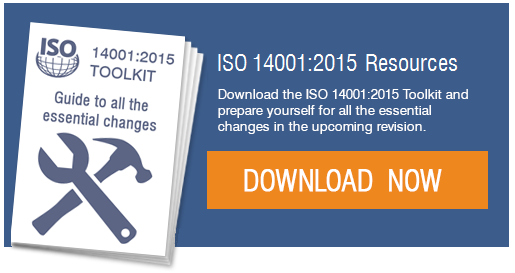Want to contribute to this article?
If you're to feel the benefit of improved environmental performance, and to remove any barriers that prevent you from making that improvement, it's essential that your top management commit to your environmental management system (EMS).
By assigning responsibilities to top management, you can more effectively integrate environmental factors into your business processes, and consider environmental issues as part of a long-term sustainable business plan.
In this second part of our four-part series, we explain what the ISO 14001 revision means for your organisation, and focus on what management will need to do to adapt.
Reconnecting top management with environmental management
In the new ISO 14001, there are three key changes that concern leadership:
- A new 'Leadership and commitment' clause
- Extensions to requirements of the environmental policy
- Updates to clauses concerning organisational roles, responsibilities and authorities
Leadership and commitment
The new 'Leadership and commitment' clause (clause 5.1) says that top management must not delegate certain roles, and should take responsibility for a number of aspects of the EMS, including:
- Considering environmental performance in strategic planning
- Formulating environmental policy
- Communicating the importance of effective environmental management (including, but not limited to, conforming to the EMS)
- Supporting manager roles relevant to the EMS
- Promoting continuous improvement
- Establishing the organisation's environmental policy
- Reviewing and monitoring the EMS
Essentially, you must ensure that your top management holds some direct responsibility and accountability for the EMS so that environmental considerations become a routine part of your strategic planning.

A KPI dashboard such as EQMS Dashboard makes this transition much easier. This user-friendly module combines all of your GRC solutions in one single reporting framework to aid decision-making at the highest level of your organisation and simplify your communication with personnel.
Environmental policy
As well as the 2004 standard's commitment to preventing pollution, the 2015 standard also requires a comprehensive policy commitment to protecting the environment. Top management must be responsible for formulating the environmental policy, and must implement, document, communicate, and expect personnel to comply with, that policy.
When formulating the environmental policy, management may need to consider the following:
- Preventing pollution
- Using sustainable resources
- Mitigating climate change
- Environmental context of the organisation
- Responsible waste disposal
- Controlling emissions
- Compliance obligations
Roles, responsibilities and authorities
If they're to provide effective environmental leadership, your management must assign all EMS roles, responsibilities and authorities and communicate them to the relevant personnel.
There's no specific requirement for a specified management representative as set out in ISO 14001:2004. However, you must continue to ensure that the roles, responsibilities and authorities attributed to a management representative are assigned somewhere in the organisation.
What you should do now
For more information on the ISO 14001:2015 revision, check out our ISO 14001 Toolkit by clicking the link below!









Share your thoughts on this article